Abstract
Waterway tunnels, a novel type of infrastructure designed for inland waterways in mountainous gorge regions, have seen rapid development in recent years. However, their unique structural characteristics and specific shipping activities pose significant risks in the event of an accident. To enhance the scientific rigor and efficiency of emergency responses to vessel incidents in tunnels, this study focuses on fire accidents in waterway tunnels. Considering the unique challenges of emergency response in such scenarios, we propose an emergency response framework using Business Process Modeling Notation (BPMN). The framework is mapped into a Petri net model encompassing three key stages: detection and early warning, emergency response actions, and recovery. A Colored Hierarchical Timed Petri Net (CHTPN) emergency response model is then developed based on fire incident data and emergency response time functions. Furthermore, a homomorphic Markov chain is employed to assess the network’s validity and performance. Finally, optimization strategies are proposed to improve the emergency response process. The results indicate that the emergency response network demonstrates strong accessibility, effectively mitigating information bottlenecks in critical stages of the response process. The network provides accurate and rapid decision support for different tunnel ship fire scenarios, efficiently and reasonably allocating emergency resources and response teams, and monitoring the operation of key emergency response stages. This enhances the efficiency of emergency operations and provides robust support for decision-making in waterway tunnel fire emergencies.
1. Introduction
In recent years, the growing demand for inland waterway transportation has driven the construction of complex hydraulic hubs and cascade projects in mountainous gorge regions. As an emerging type of navigation facility, waterway tunnels facilitate vessel transit through mountainous areas, enhancing the efficiency of cascade navigation and resource allocation [1]. It has received increasing attention in recent years in the world. Waterway tunnels in China are currently in a rapid development and construction phase. Following the completion of the Gougpitan waterway tunnel on the Wujiang River (As shown in Figure 1), additional projects are set to commence, including the Qililong waterway tunnel on the Fuchun River in Zhejiang, silin tunnel, shatuo tunnel and the second-line navigable facilities for the Wujiang River upgrade project.
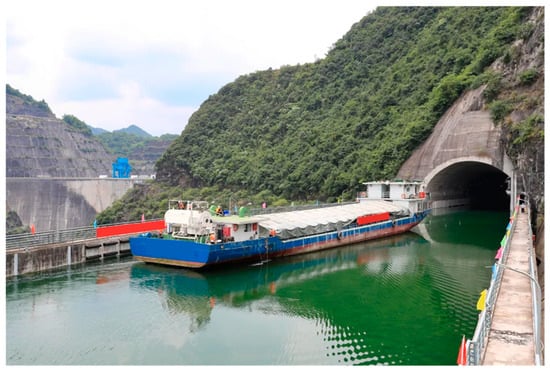
Figure 1.
Goupitan tunnel of Wujiang in China.
However, vessel behavior patterns and traffic complexity, to some extent, increase the risk of accidents [2]. In particular, due to the unique structural characteristics of waterway tunnels and the complexity of navigation activities within them, the risk of ship fire accidents in waterway tunnels is relatively high [3]. The confined space, poor ventilation, and potential accumulation of smoke and fire hazards can exacerbate the severity of such incidents, leading to disastrous consequences [4]. Additionally, the enclosed structure of waterway tunnels, often situated in remote areas, presents substantial challenges for emergency response efforts. These factors highlight the necessity of targeted research on emergency response strategies for vessel fire incidents in waterway tunnels. This study aims to develop an emergency response framework and establish a response network to address these challenges, providing valuable guidance and support for emergency response planning and decision-making.
Tunnel fires are highly hazardous incidents, and research on emergency responses to such events has garnered significant attention in recent years. Luan et al. [5] and Liu et al. [6] investigated smoke movement dynamics in tunnel environments and analyzed the effects of ventilation and smoke extraction systems on the heat release rate. Li et al. [7] modeled the emergency process of subway fires using a Petri net-based SFERP-Net and proposed priority criteria, including critical task priority strategies and shorter-waiting-time priority strategies, to resolve detected conflicts and optimize process execution time. Bjelland et al. [8] applied a systems theory approach to analyze the complexity of tunnel systems and promoted appropriate control structure designs for critical processes from the design phase to actual emergencies. Njå O et al. [9] and Chen et al. [10] analyzed tunnel accident case studies, identifying safety issues in pre- and post-incident stages, and proposed future requirements for emergency planning. Zhou et al. [11,12,13] introduced the domino effect into Petri net modeling to analyze and evaluate the efficiency of emergency response actions, using fire accidents as examples. Pan et al. [14] and Xu et al. [15] constructed emergency response models based on colored, hierarchical, and timed Petri nets to analyze emergency response time and inform decision-making during emergencies. Wu et al. [16] investigated the explosion chamber in the shape of a ventilation duct in the cabin, and based on this, conducted an experimental analysis of the effect of tunnel length on explosion overpressure. Nils et al. modified and adjusted the tunnel fire scenarios and proposed a multi-zone modeling method for tunnel fires, which was validated using experimental data [17].
In summary, current research on tunnel emergency response primarily focuses on two areas: emergency plan development and the digitization of emergency response processes [18,19]. Regarding emergency process modeling, studies by domestic and international scholars mainly utilize approaches such as deep learning [20], BPMN [21], Petri nets [22,23,24], and virtual reality [25]. However, these studies predominantly focus on road and railway tunnels [26,27]. As an emerging facility, waterway tunnels for vessels have received far less attention compared to road and railway tunnels. Research on emergency response processes, efficiency, and decision-making for waterway tunnels remains scarce. Consequently, further studies are urgently needed to address these aspects for vessel waterway tunnels.
However, while the BPMN emergency response framework provides an intuitive representation of emergency actions, it lacks the capability to quantitatively evaluate the efficiency and performance of these actions. In contrast, the widespread use of Petri nets in emergency response and decision-making offers significant advantages for quantitative analysis of emergency efficiency [28]. By integrating BPMN with Petri nets, it becomes possible to analyze critical elements of the emergency response within an intuitive process framework. This approach facilitates the identification of response mechanisms and bottlenecks, enhances the operational efficiency of emergency processes, and supports the implementation of appropriate emergency measures. Meanwhile, compared to methods such as deep learning, the CHTPN model offers a clear structure and strong formal expressiveness, while requiring less modeling data, making it more suitable for scenarios where real accident data in ship tunnels are lacking [29,30].
This study aims to construct a Petri net model for emergency response to vessel fire incidents in waterway tunnels by integrating BPMN and Petri net frameworks. By incorporating fire incident information into a color-coded scheme, the model facilitates hierarchical decision-making for controlling ventilation systems, directing evacuations, and preparing emergency personnel. Based on the integration with evacuation action timing, a waterway tunnel vessel fire emergency response network is proposed using a CHTPN. This network systematically delineates the sequence and dependencies between various stages and activities within the emergency response process. It provides a theoretical reference for emergency command personnel, enabling informed decision-making, improving response efficiency, and ensuring greater reliability and effectiveness in emergency management.
2. Materials and Methods
2.1. BPMN
Business Process Modeling Notation (BPMN) is a process language designed to bridge the gap between business process design and implementation [31]. By providing a graphical representation, BPMN facilitates the visualization of business processes, serving as a tailored diagramming technique for creating graphical models of process operations. Its syntax is built upon four fundamental elements:
- (1)
- Flow Objects: Represent the overall workflow. The three primary flow objects are: Events: Triggers that initiate, modify, or complete a process. Activities: Tasks performed by individuals or technology. Gateways: Decision points within the workflow.
- (2)
- Swim lanes: Illustrate the activities assigned to each participant.
- (3)
- Connecting Objects: Describe how the elements of the process are related. There are three types of connecting objects: Sequence Flows: Indicate the order in which activities are executed. Message Flows: Represent communication between departments. Associations: Link artifacts to events, activities, or gateways.
- (4)
- Artifacts: Provide supplementary information about the process. Artifacts include: Data Objects: Represent the data required for activities. Groups: Indicate logical groupings of activities. Annotations: Clarify various aspects of the diagram.
2.2. Petri Net
Petri nets are a powerful graphical and mathematical modeling framework well-suited for representing and analyzing discrete systems characterized by concurrency, asynchrony, distribution, parallelism, nondeterminism, and randomness [32]. The core of Petri net theory lies in the rules governing transition enabling and firing. The system’s initial state is referred to as the initial marking M0. The underlying graph N of a Petri net is a directed, weighted bipartite graph, comprising two types of nodes: places and transitions. The arcs represent the flow between a place and a transition or vice versa. In graphical notation, places are depicted as circles, transitions as bars or rectangles, and arcs are annotated with weights. A weight k on an arc can be interpreted as representing k parallel arcs. The formal definition of a Petri net is summarized in Table 1.

Table 1.
Petri net definition.
This study analyzes the performance of the Petri net model primarily using two metrics: place occupancy rate and transition utilization rate. Place Occupancy Rate: This metric is defined as the ratio of the time a place is occupied to the total time, calculated as:
where represents the probability that place contains exactly j tokens when the Petri net reaches a steady state.
Transition Utilization Rate: This metric measures the ratio of the number of times a transition is activated to its total possible activations within a given time. The value reflects the importance of the transition in the Petri net and indicates the potential for system performance optimization, calculated as:
where E represents the set of all reachable states for the transition.
2.3. Fire Development Process in Waterway Tunnel
Due to variations in structure, personnel involved, incident location, and response mechanisms, accidents in waterway tunnels can lead to differing levels of severity. When examining the details of each discrete moment, the general timeline of a tunnel fire is illustrated in Figure 2. As shown in the figure, numerous action branches in the emergency response process—such as extinguishing the fire, evacuating personnel, and conducting rescues—can significantly impact the incident’s outcomes. By clarifying the workflows of each emergency response team and breaking down the response process into three stages—pre-incident, during the incident, and post-incident—a foundational framework for constructing the emergency response network is established.
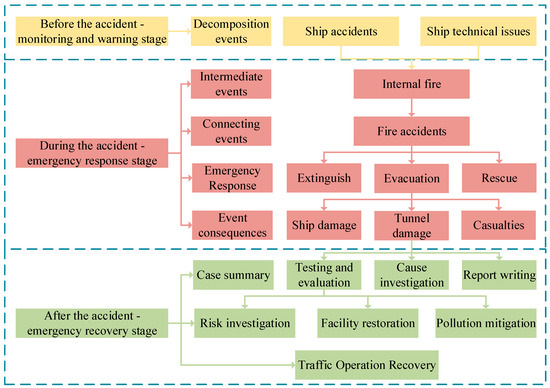
Figure 2.
Time evolution of a ship fire scenario in a tunnel.
3. Results
3.1. BPMN Overall Emergency Framework
The BPMN-based comprehensive emergency framework for waterway tunnel fires constructed in this study includes three pools: evacuating personnel, waterway tunnel emergency agencies, and external rescue forces. These pools are aligned along the timeline of the emergency response cycle, encompassing the stages of monitoring and early warning, emergency handling, and emergency recovery. This timeline facilitates accurate task placement within the appropriate phase of the emergency response cycle. The detailed structure is illustrated in Figure 3.
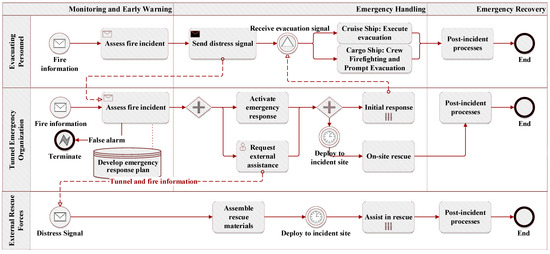
Figure 3.
BPMN overall emergency framework.
3.2. Emergency Response Framework for Each Stage of Incident
3.2.1. Pre-Incident Stage—Monitoring and Early Warning
The monitoring and early warning stage is the initial step in emergency response and is critical for subsequent fire incident handling and recovery. As shown in Figure 4, the emergency response framework for this stage involves three main entities: evacuating personnel, the waterway tunnel emergency command center, and the waterway tunnel monitoring team. (1) Evacuating Personnel: Upon detecting a fire source or smoke, or upon receiving an alarm from detectors, personnel confirm the fire incident. They then report the fire to the command center via the emergency communication system and notify nearby vessels. The captain or designated personnel organizes evacuation efforts. (2) Emergency Command Center: If the fire is not visually observed and detectors malfunction, the tunnel fire detectors provide a reliable means for fire confirmation, though such occurrences are rare. (3) Monitoring Team: Following the command center’s instructions, the team activates fire alarms, prepares emergency equipment, and continuously feeds back information on the fire source and evacuation status to the command center to ensure the implementation of emergency decisions.
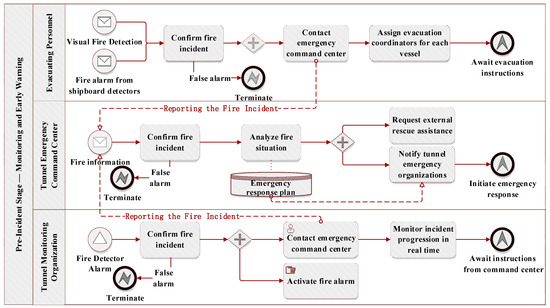
Figure 4.
Monitoring and early warning stage process.
3.2.2. Incident Stage—Emergency Handling
As the most critical phase of the emergency response process, the emergency handling stage determines the success of rescue operations. This phase involves eight key units. Part of it is shown in Figure 5. Except for Evacuating Personnel, the remaining seven parts are as follows.
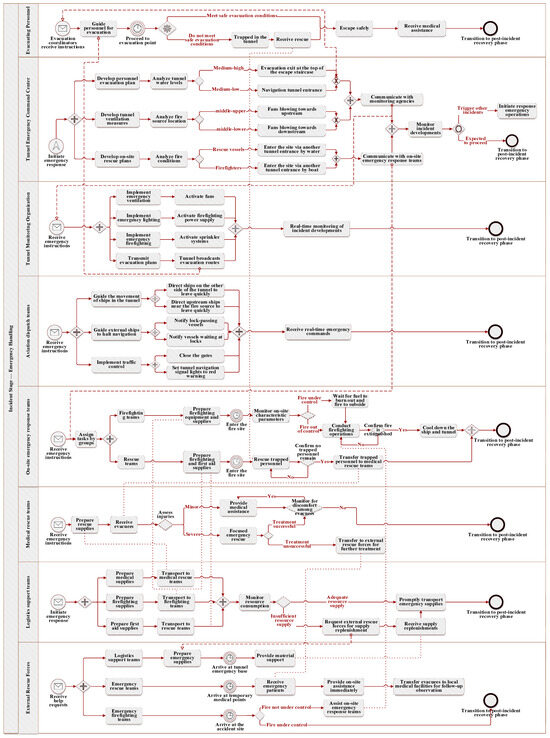
Figure 5.
Emergency response stage—emergency response team process.
- (1)
- Emergency Command Center: Upon confirming that all teams have entered fire emergency mode, the command center formulates evacuation, ventilation, and rescue plans. Based on analyses of evacuation routes and times, it identifies the optimal evacuation paths and exits to avoid fire and toxic smoke as much as possible. The ventilation plan adjusts fan directions based on the fire’s location to control smoke spread. The rescue plan selects firefighting equipment and protective gear according to the fire type, monitors the incident in real time, and activates contingency plans in case of secondary accidents.
- (2)
- Waterway Tunnel Monitoring Team: Following decisions from the command center, the monitoring team activates the ventilation system, issues evacuation notices, switches to firepower and emergency lighting systems, and monitors the fire’s development in real time.
- (3)
- Navigation Scheduling Team: The team directs vessels on the unaffected side to evacuate, assists rescue boats in entering the tunnel, halts external vessel traffic, and adjusts traffic signals in real time.
- (4)
- On-Site Emergency Response Team: This team is divided into firefighting and rescue groups. The firefighting group enters the fire site, uses on-site equipment to control the fire, and advances further once visibility improves. The rescue group searches for trapped individuals and assists with evacuation.
- (5)
- Medical Rescue Team: This team provides on-site medical assistance to those with minor injuries and uses emergency equipment to treat severely injured individuals. If necessary, they transfer critically injured persons to external rescue medical institutions.
- (6)
- Logistics Support Team: Responsible for supplying firefighting and medical materials, the team reports supply status to the command center and requests external support when resources are insufficient.
- (7)
- External Rescue Forces: These forces, varying in arrival times, deliver rescue personnel and materials via waterways. The rescue group prioritizes treating severely injured individuals and transferring them to medical institutions, while the firefighting group assists in extinguishing the fire on-site.
3.2.3. Post-Incident Stage—Emergency Recovery
Following the emergency handling stage, although the fire source is extinguished, residual fuel from the vessels may spread within and beyond the tunnel. Monitoring equipment should be used to assess the concentration of explosive gases and remove any remaining fuel. After external firefighting teams confirm the fire is completely extinguished, the tunnel monitoring team deactivates the fire alarms, signaling the transition to the recovery stage. Once on-site personnel confirm that water quality and the concentration of explosive gases within the tunnel meet safety standards, the emergency command center dispatches engineers to enter the tunnel under on-site assistance. The engineers assess structural damage and investigate the cause of the fire. Concurrently, designated personnel record the property and personal losses of evacuated individuals and compile an incident report. At this point, the emergency response concludes. The emergency response framework for the recovery stage is illustrated in Figure 6.
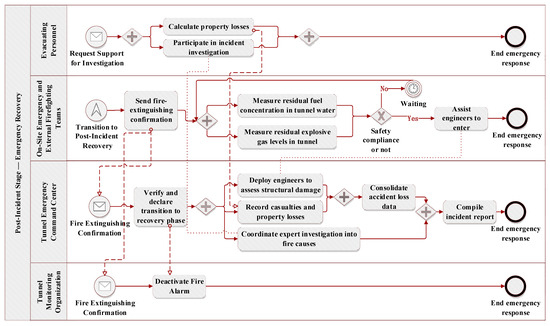
Figure 6.
Emergency recovery stage process.
3.3. Mapping and Representation of the Emergency Response CHTPN Model
3.3.1. Construction of Petri Net Model for Emergency Response
Mapping BPMN to Petri nets requires associating the nodes, connections, and process information in BPMN with corresponding elements in the Petri net model. Specifically, this involves establishing the mapping relationships between the elements of the BPMN emergency response framework—representing the stages of monitoring and early warning, emergency handling, and emergency recovery—and the places and transitions in the Petri net. Additionally, the procedural expressions in the BPMN framework are mapped to the arcs in the Petri net. The mapping rules used in this study for associating BPMN events, activities, and gateways with basic Petri net constructs are shown in Table 2.

Table 2.
Mapping rules.
Based on the proposed mapping rules, the BPMN emergency response process framework is transformed into the Petri net model illustrated in Figure 7.
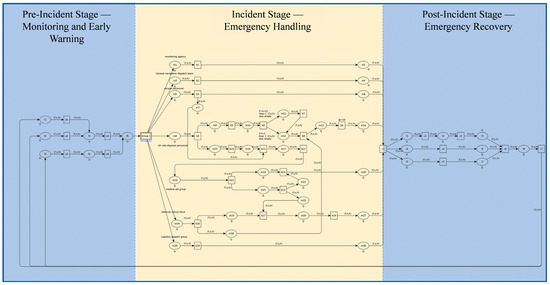
Figure 7.
Petri net for emergency response to fire in waterway tunnel.
After the Petri net process framework is constructed, the next step is to clearly define the places and transitions. The attribute definitions of places and transitions in the parent Petri net model, established based on the three-stage emergency response framework of BPMN, are shown in Table 3.

Table 3.
Attribute definitions of places and transitions in the Petri net parent model.
3.3.2. Emergency Response CHTPN Model Extension
Building on the standard Petri net framework, the CHTPN was adopted to extend the waterway tunnel fire emergency response framework. This approach retains the basic elements and rules of Petri nets while introducing colored tokens and time variables to more accurately represent various states within the model.
- (1)
- Emergency response Petri net coloring expression
Based on the fire emergency response process outlined in the previous section, three color sets were defined to represent different factors in complex ship fire scenarios: Color Set F: Represents the relative position of the burning vessel within the waterway tunnel, denoted by the numbers 1–3. Color Set S: Corresponds to fire types categorized based on the nature of vessel combustibles, denoted by the numbers 1–5. Color Set H: Represents the navigation water level of vessels within the tunnel, denoted by the numbers 1–2.
- (2)
- Emergency response Petri net hierarchical expression
During the initial phase of emergency handling, analyses and decisions must be made regarding personnel evacuation strategies, tunnel ventilation measures, and the firefighting equipment allocation for the on-site emergency response team. These steps ensure targeted and differentiated emergency decisions for complex fire scenarios. To reduce model redundancy and improve its readability, a substitute transition Group1 can be implemented to link the emergency decision-making model preceding the execution of the emergency response plan (Figure 8, Subnet Group1). This subnet uses color set variables to determine the optimal emergency response plan. By employing this method, emergency decision-makers can better understand and manage complex emergency situations, thereby enhancing the efficiency and accuracy of emergency responses.
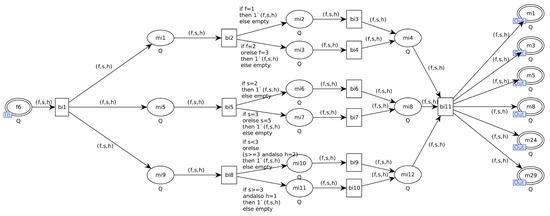
Figure 8.
Emergency response Petri net subnet (Group1).
Upon receiving and confirming the occurrence of a vessel fire, the emergency command center initiates three parallel actions: mi1–mi4: Gather the location information of the burning vessel from tunnel monitoring equipment or onboard personnel. mi5–mi8: Obtain fire condition information from the fire discoverer or personnel on the burning vessel to confirm the location and type of the fire within the vessel. mi9–mi12: Acquire navigation information from tunnel regulatory personnel to identify the current water level at which the vessel is navigating within the tunnel. The places and transitions in the Petri subnet corresponding to these emergency decision-making processes are defined in Table 4.

Table 4.
Emergency response Petri subnet place and transition definition.
- (3)
- Emergency response Petri net time expression
When a ship fire occurs in a waterway tunnel, the primary concern of the emergency response team is ensuring the safe evacuation of personnel. Therefore, time data, from the start of the fire to the safe evacuation of personnel, the completion of firefighting and cooling, and the conclusion of the emergency response actions, need to be closely monitored. By attaching timestamps to transitions that represent evacuation times in the Petri net, temporal expressions can be implemented within the model.
Since there are currently no real-world cases of ship fires in waterway tunnels available for study, research on the distribution of emergency response times in highway tunnel fires both domestically and internationally has been referenced [33,34,35]. It is assumed that the duration of emergency actions in the Petri net for waterway tunnel ship fires follows a normal distribution. The probability density function of the normal distribution is assigned as shown in Table 5, where the mean (μ) represents the average duration of the emergency actions, and the standard deviation (σ) represents the degree of variation in the duration of the emergency actions.

Table 5.
Lognormal distribution parameters of transition times.
4. Discussion
4.1. Model Effectiveness Analysis
The validity analysis of a Petri net model typically includes deadlock, livelock, safety, and reachability. For the reachability set, all possible states that each transition can reach must be determined, which requires establishing the reachability representation set of the constructed emergency response Petri net model.
Petri nets are isomorphic to continuous-time Markov chains, where the waiting time for each transition follows an exponential distribution, and the token count in each place can be considered a continuous-time random variable. Under these conditions, the Petri net can be converted into a continuous-time Markov chain, enabling performance analysis and optimization. Using the Petri net model and reachability marking set, the continuous-time Markov chain for emergency response in the specific scenario of a ship fire in a waterway tunnel is established, as shown in Figure 9.
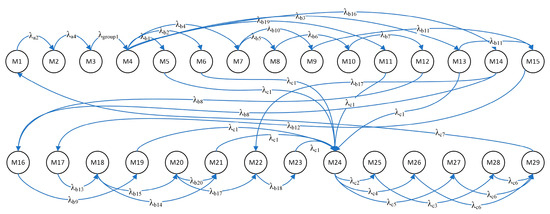
Figure 9.
Petri net model isomorphic Markov chain.
Validation and analysis confirm the following: (1) The established Markov chain ensures that no place is unable to acquire the required tokens for further state transitions, indicating that the emergency response Petri net is free of deadlock. (2) All possible states of the Markov chain can reach a satisfactory state, proving that the emergency response Petri net is free of livelock. (3) The token count in the places of the Petri net does not become negative, and transitions do not occur simultaneously, confirming the safety of the emergency response Petri net. (4) The Petri net satisfies reachability since all reachable states can be achieved through a sequence of transitions starting from the initial state.
4.2. Model Performance Analysis
A steady state in a Petri net refers to a condition where the occurrence rates of all transitions and the number of tokens in places remain constant. The steady-state probability distribution describes the distribution that the system reaches over a long period. In the steady state, the transition rate from state A to state B must equal the transition rate from state B to state A. Based on this principle, the steady-state probability equations are derived, as shown in Equation (3).
By solving the equations using the transition occurrence rates, the steady-state probabilities of reachable states are obtained, as shown in Table 6. States M1 to M3 correspond to the pre-event monitoring and warning stage, M4 to M23 to the mid-event emergency handling stage, and M24 to M29 to the post-event recovery stage.

Table 6.
Reachable steady-state probability.
It can be observed that during the mid-event emergency handling stage, states M9, M10, M12, and M15 have significantly higher steady-state probabilities than other states in the same phase. This indicates that these states are visited more frequently, highlighting the critical role of on-site response team actions in the emergency response process. These states greatly influence the operational efficiency of the entire emergency response network.
- (1)
- Place Occupancy Rate
The occupancy rates of places are calculated using the reachability set and the place-identification matrix, as shown in Figure 10.

Figure 10.
Place occupancy rate.
From the figure, it shows that places m11, m12, m13, m16, and m17 have occupancy rates greater than 0.01. A high place occupancy rate indicates that the state represented by the place could be a bottleneck in the system, with resource utilization reaching or nearing its limit. Under such conditions, if other places require the same resource, resource shortages may occur, leading to increased system response times or incomplete task execution. Specifically:
- (1)
- Places m11, m12, m13: These are associated with the on-site firefighting team. They represent the team’s ability to control the fire size and coordinate with external firefighting forces. The high occupancy rate suggests that a significant amount of network resources is allocated to fire suppression efforts. This highlights the need to provide ample operational time and firefighting materials to the team.
- (2)
- Places m16, m17: These are linked to the on-site rescue team. They signify the team’s responsibility to promptly reach evacuation exits, assess whether any individuals remain trapped, and allocate substantial manpower, materials, and time to assist with evacuation and provide medical aid until confirming that no one is left behind in the tunnel.
High occupancy rates may lead to resource shortages and prolonged response times. To mitigate these issues, the following measures can be implemented: (1) Refining Places: Increase the number of places by subdividing existing ones to distribute resource demands more evenly. (2) Resource Allocation and Task Scheduling: Prioritize resources and schedule tasks based on the demands and priority levels of each place. (3) Expanding Resource Availability: Increase the overall quantity of available resources to reduce bottlenecks and improve system efficiency.
- (2)
- Transition Utilization Rate
Using the reachability set and the place–transition matrix, the transition utilization rates were calculated and are presented in Figure 11.
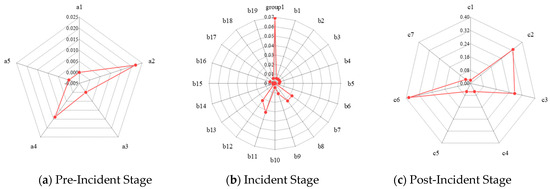
Figure 11.
Transition utilization rate.
From the figure, it is evident that transitions Group1, b7, b8, b11, and b12 have utilization rates greater than 0.02. High transition utilization rates typically indicate the most frequent events or actions within the system, or they highlight critical steps in the response process. The key observations are as follows:
- (1)
- The highest utilization rate is observed for Group1, which corresponds to the emergency decisions made by the emergency command center based on the incident scenario. This underscores the critical role of decision-making in the emergency response process. It directly affects the efficiency of subsequent teams in receiving fire incident information and commands. Emergency commanders should focus on minimizing delays in this step, ensuring that instructions are communicated to all emergency teams quickly, clearly, and effectively.
- (2)
- b7 and b8: These transitions are associated with the on-site firefighting team. The high utilization rates indicate: Transition b7: Represents the time required for the fire’s intensity to decrease, which incurs a time cost. Transition b8: Represents taking firefighting actions that require external firefighting forces to assist before progressing to the next phase. Both transitions are frequently accessed in the emergency network, highlighting the need to confirm fire reduction time and the arrival of external firefighting forces before proceeding. These observations align with the conclusions derived from the high occupancy rates of m10, m12, and m13.
- (3)
- b11 and b12: These transitions are linked to the on-site rescue team. The high utilization rates indicate: Transition b11: Represents entering the accident site to rescue trapped individuals. This transition requires confirmation that all trapped personnel have been rescued before moving to the next phase. Transition b12: Represents transferring evacuees to the medical assistance team. This requires the presence of evacuees, the rescue team, and the medical team before proceeding to the next phase. These frequent accesses align with the high occupancy rates of m16 and m17.
A high transition utilization rate does not necessarily indicate flaws in the Petri net design or system issues. Instead, it accurately reflects the actual operational state of the Petri net model, helping to understand the mechanisms and bottlenecks within the emergency response network. By optimizing the events or actions associated with high transition utilization rates, it is possible to significantly improve response efficiency and reduce response times during emergency operations.
5. Conclusions
This study integrates the development of ship fire accidents in waterway tunnels with emergency response processes. A BPMN-based process-oriented framework for waterway tunnel fire emergency response was established. Based on structural mapping, a Petri net model for waterway tunnel fire emergency response was constructed, and a CHTPN emergency response network was developed for effectiveness and performance analysis. The key findings are as follows:
The BPMN framework provides a graphical representation of the emergency response process, offering an intuitive view of the steps and workflows. This visualization helps personnel better understand and manage emergency procedures, improving response efficiency and accuracy. It reduces the likelihood of human error and enhances the ability to handle unexpected events effectively. Verification and analysis confirm that the constructed colored hierarchical timed Petri net for emergency response does not have deadlocks or livelocks. This satisfies the safety and reachability criteria. The constructed model has good effectiveness.
The analysis of place occupancy rate and transition utilization rates reveals potential information bottlenecks in the on-site firefighting team’s assessment of the fire intensity and the collaboration with external forces for firefighting including the on-site rescue team’s efforts to assist trapped evacuees. These critical nodes are pivotal in waterway tunnel fire emergency response and require efficient and orderly execution. Monitoring the performance of these key response stages can help emergency commanders provide precise and timely decision-making under varying fire scenarios. This ensures the rational and effective allocation of resources and teams, enhancing the overall reliability of emergency response operations.
Future research should further incorporate real ship tunnel accident cases or simulation data to supplement and refine the emergency response time distribution. Additionally, the applicability of existing tunnel emergency response frameworks to specific scenarios in specific tunnels should be examined.
Author Contributions
Conceptualization, J.D. and S.L.; methodology, S.L.; software, S.L. and X.Z.; validation, S.L. and X.Z.; formal analysis, S.L.; investigation, J.D.; resources, J.D.; data curation, X.Z.; writing—original draft preparation, S.L. and X.Z.; writing—review and editing, J.D. and S.L.; visualization, S.L.; funding acquisition, J.D. All authors have read and agreed to the published version of the manuscript.
Funding
This research was funded by The National Natural Science Foundation of China, grant number 52271368 and The Independent Innovation Fund of the National Key Laboratory of Water Traffic Control, grant number SKL202403.
Institutional Review Board Statement
Not applicable.
Informed Consent Statement
Not applicable.
Data Availability Statement
The original contributions presented in the study are included in the article, further inquiries can be directed to the corresponding author.
Conflicts of Interest
The authors declare no conflicts of interest.
References
- Xie, C.; Huang, L.W.; Wang, R.; Deng, J.; Shu, Y.Q. Ship fire modelling and evacuation simulation in navigation tunnel. Tunn. Undergr. Space Technol. 2022, 126, 104546. [Google Scholar] [CrossRef]
- Yu, Y.R.; Liu, K.Z.; Wei Kong, W.; Xin, X.R. Time-evolving graph-based approach for multi-ship encounter analysis: Insights into ship behavior across different scenario complexity levels. Transp. Res. A Policy Pract. 2025, 194, 104427. [Google Scholar] [CrossRef]
- Díaz, R.S.; Lantsoght, E.; Hendriks, M.A.N. Structural behaviour of tunnels exposed to fire using numerical modelling strategies. Fire Safety J. 2025, 152, 104335. [Google Scholar] [CrossRef]
- Hu, P.; Xu, T.; Liu, C.; Wang, K.; Chong, F.; Shang, F.; Wu, J. Study on Smoke Characteristics in Cavern Complexes of Pumped-Storage Power Stations. Fire 2024, 7, 453. [Google Scholar] [CrossRef]
- Luan, D.; Chu, T.Y.; Bielawski, J.; Fan, C.G.; Węgrzyński, W.; Huang, X.Y. Smoke movement and stratification of tunnel fires under coupled effects of rainfall and ventilation. Fire Saf. J. 2025, 152, 104323. [Google Scholar] [CrossRef]
- Liu, Q.L.; Xu, Z.S.; Zhang, Y.C.; Xie, B.C.; Yin, Y.L. Study on the effect of centralized smoke exhaust on the heat release rate of tunnel fire. Int. J. Therm. Sci. 2025, 210, 109627. [Google Scholar] [CrossRef]
- Li, Q.M.; Deng, Y.L.; Liu, C.; Zeng, Q.T.; Lu, Y. Modeling and analysis of subway fire emergency response: An empirical study. Saf. Sci. 2016, 84, 171–180. [Google Scholar] [CrossRef]
- Bjelland, H.; Njå, O.; Heskestad, A.W.; Braut, G.S. Emergency preparedness for tunnel fires—A systems-oriented approach. Saf. Sci. 2021, 143, 105408. [Google Scholar] [CrossRef]
- Njå, O.; Svela, M. A review of competencies in tunnel fire response seen from the first responders’ perspectives. Fire Saf. J. 2018, 97, 137–145. [Google Scholar] [CrossRef]
- Chen, Z.H.; Zhou, X. Emergency Rescue Scheme of Super Long Lake Tunnel. Traffic Transp. 2021, 37, 34–38. [Google Scholar] [CrossRef]
- Zhou, J.F.; Reniers, G. Petri-net based evaluation of emergency response actions for preventing domino effects triggered by fire. J. Loss Prev. Process Ind. 2018, 51, 94–101. [Google Scholar] [CrossRef]
- Zhou, J.F.; Reniers, G. Probabilistic Petri-net addition enabling decision making depending on situational change: The case of emergency response to fuel tank farm fire. Reliab. Eng. Syst. Saf. 2020, 200, 106880. [Google Scholar] [CrossRef]
- Zhou, J.F.; Peng, L. Reversed Fuzzy Petri nets based Accident Causation Analysis under Emergency Response. J. Catastrophol. 2015, 30, 124–126. [Google Scholar] [CrossRef]
- Pan, W.J.; Wang, L.; Yin, H.R.; Zhu, X.P. Modeling and Analysis of Airport Emergency Rescue Plan Based on Petri Net. Aeronaut. Comput. Tech. 2021, 51, 6–9. [Google Scholar] [CrossRef]
- Xu, C.C.; Shao, Q. Optimization of Emergency Resource Allocation Super—High Plateau Airport Based on Timed Petri Net. Aeronaut. Comput. Tech. 2019, 49, 67–72. [Google Scholar] [CrossRef]
- Wu, X.D.; Miao, X.M.; Gong, M.; Su, J.P.; Zhu, Y.Q.; Chen, X.L. Vibration Safety Threshold and Control Technology for Blasting to Prevent Seawater Intrusion in Coastal Tunnel Sections Near Faults. J. Mar. Sci. Eng. 2024, 12, 1646. [Google Scholar] [CrossRef]
- Nils, J.; Enrico, R.; Rugiada, S.; Michele, F. The use of multi-zone modelling for tunnel fires. Tunneling Undergr. Space Technol. 2023, 134, 104996. [Google Scholar] [CrossRef]
- Cai, J.T.; Wu, J.S.; Yuan, S.Q.; Reniers, G.; Bai, Y.P. Risk-based optimization of emergency response systems for accidental gas leakage in utility tunnels. Reliab. Eng. Syst. Saf. 2024, 244, 109947. [Google Scholar] [CrossRef]
- Zhang, Z.Y.; Yao, X.W.; Xing, Z.Y.; Zhou, X.Y. Simulation on passenger evacuation of metro train fire in the tunnel. Chaos Solitons Fractals 2024, 187, 115429. [Google Scholar] [CrossRef]
- Guo, C.; Hu, L.F.; Zhang, Y.X.; Zhu, H.H.; Yan, Z.G. Study on the general framework for real-time heat release rate inversion of tunnel fires with deep learning and transfer learning. Tunn. Undergr. Space Technol. 2024, 148, 105751. [Google Scholar] [CrossRef]
- Yang, Q.T.; Guo, W.Y.; Ni, W.N.; Zeng, Q.T. Automatic extraction method and implementation of BPMN model for emergency plan response process. Comput. Integr. Manuf. Syst. 2022, 28, 3212–3224. [Google Scholar] [CrossRef]
- Zhou, J.F.; Reniers, G. Petri-net based cooperation modeling and time analysis of emergency response in the context of domino effect prevention in process industries. Reliab. Eng. Syst. Saf. 2022, 223, 108505. [Google Scholar] [CrossRef]
- Brozovic, V.; Kezic, D.; Bosnjak, R.; Krile, S. Implementation of International Regulations for Preventing Collisions at Sea Using Coloured Petri Nets. J. Mar. Sci. Eng. 2023, 11, 1322. [Google Scholar] [CrossRef]
- Liang, W.T.; Gaosheng Yang, G.S. Modeling and analysis on emergency management process of metro system during operation period based on colored Petri net. J. Saf. Sci. Technol. 2023, 19, 179–185. [Google Scholar] [CrossRef]
- Zhang, X.C.; Chen, L.J.; Jiang, J.H.; Ji, Y.X.; Han, S.Y.; Zhu, T.; Xu, W.B.; Tang, F. Risk analysis of people evacuation and its path optimization during tunnel fires using virtual reality experiments. Tunn. Undergr. Space Technol. 2023, 137, 105133. [Google Scholar] [CrossRef]
- Wang, X.; Liu, B.; Ma, W.; Feng, Y.; Li, Q.; Sun, T. Simulations on Evacuation Strategy and Evacuation Process of the Subway Train Under the Fire. Fire 2024, 7, 464. [Google Scholar] [CrossRef]
- Zhu, R.; Zhang, D.M.; Huang, Z.K.; Guo, X.Y.; Gan, B.L.; Zhou, W.D. Traffic-based resilience assessment on urban road tunnel affected by fire accident. Tunn. Undergr. Space Technol. 2025, 161, 106543. [Google Scholar] [CrossRef]
- Maria, D.; Panagiotis, T. A colored petri net-based modeling method for supply chain inventory management. Simulation 2022, 98, 257–271. [Google Scholar] [CrossRef]
- Mecheraoui, K.; Lomazova, I.A.; Nabil Belala, N. A Petri net extension for systems of concurrent communicating agents with durable actions. J. Parallel Distrib. Comput. 2021, 155, 14–23. [Google Scholar] [CrossRef]
- Cherif, G.; Leclercq, E.; DLefebvre, D. Scheduling of a class of partial routing FMS in uncertain environments with beam search. J. Intell. Manuf. 2023, 34, 493–514. [Google Scholar] [CrossRef]
- Sholiq, S.; Yaqin, M.A. BPMN diagram dataset: Comprehensive collection of functional requirements. Data Brief 2024, 57, 110882. [Google Scholar] [CrossRef] [PubMed]
- Su, Y.; Qi, L.; Zhou, M.C. A Backward Algorithm to Determine the Existence of Legal Firing Sequences in Ordinary Petri Nets. IEEE Robot. Autom. Lett. 2023, 8, 1–8. [Google Scholar] [CrossRef]
- Zhang, Y.X.; Zhang, X.N.; Huang, X.Y. Design a safe firefighting time (SFT) for major fire disaster emergency response. Int. J. Disaster Risk Reduct. 2023, 88, 103606. [Google Scholar] [CrossRef]
- Fabio, B.; Alessio, F.; Marco, D.; Igino, L.; Cristian, T. Road Tunnels Operation: Effectiveness of Emergency Teams as a Risk Mitigation Measure. Sustainability 2022, 14, 15491. [Google Scholar] [CrossRef]
- Bai, J.Y.; Liao, H.M.; Xia, Y.Y. Study on Fire Accidents in Tunnels. IOP Conf. Ser. Mater. Sci. Eng. 2020, 741, 012095. [Google Scholar] [CrossRef]
Disclaimer/Publisher’s Note: The statements, opinions and data contained in all publications are solely those of the individual author(s) and contributor(s) and not of MDPI and/or the editor(s). MDPI and/or the editor(s) disclaim responsibility for any injury to people or property resulting from any ideas, methods, instructions or products referred to in the content. |
© 2025 by the authors. Licensee MDPI, Basel, Switzerland. This article is an open access article distributed under the terms and conditions of the Creative Commons Attribution (CC BY) license (https://creativecommons.org/licenses/by/4.0/).













